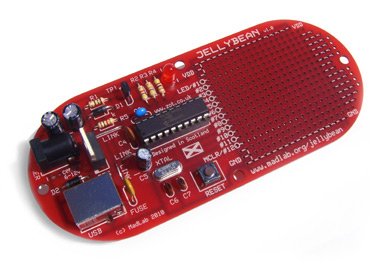| |

JellyBean
A low-cost USB-based prototyping board for user projects. Cheap enough to use as a one-time board or can be re-used many times.
Similar in concept to the Arduino but with the differences detailed below.
Features:
- supplied as a kit. No surface-mount components which makes assembly easy even for relative beginners. Only one chip, in a 20-pin DIP package.
- USB bus powered or externally powered with automatic switching between power sources. For many applications USB power is sufficient (100mA with the option to request 500mA). An external power source can be used when high currents are required for driving servo or DC motors etc. A self-resetting fuse is included to protect the USB host from over-current situations.
- 'sea of holes' for user circuits
- onboard pushbutton (processor reset or available to user programs) & onboard red LED
- integrated development environment using a dialect of the popular BASIC programming language. Simple for beginners to use yet powerful enough for many programming tasks.
- comprehensive help with example circuits and component sources
- Wizard to configure peripherals and automatically generate BASIC code
- libraries support analogue and digital I/O, UART and SPI serial comms, PWM, timers, interrupts, servo and stepper motors, LCD
- fast - on a modern PC, a "hello world" type program compiles, downloads and executes in less than 1 second (and with a single key press)
- not supplied with USB cable/CD-ROM to reduce cost (download application)
- Windows 10 compatible
Differences between JellyBean and Arduino:
- JellyBean is a self-assembly kit whilst Arduinos are pre-assembled. This allows JellyBean to be a little cheaper plus you also have the satisfaction of building it.
- JellyBean includes a 'sea of holes' prototyping area whilst Arduinos need an additional shield board. For small projects the prototyping area will be sufficient for the extra components needed. This reduces the total cost of a project.
- JellyBean's available program memory is 8 kbytes and available RAM memory is 256 bytes. On Arduinos these figures are higher (particularly with the larger members of the Arduino family). However the memory available with JellyBean is sufficient for many, even quite complex, projects.
- The JellyBean programming language is a dialect of BASIC which has for many years been used to introduce people to programming. Arduino uses a variant of the C language which is more powerful for experienced programmers but perhaps a little offputting for beginners.
- JellyBean is Microsoft Windows only. Arduino can also be hosted on Linux and Mac systems.
- JellyBean has 5V I/O only, Arduino has 3.3V and 5V I/O.
Construction notes (87KB) |
User manual (172KB) |
BASIC reference (335KB) |
Application installer v1.2 (zipped, 1.5MB) |
readme.txt |
Schematic |
Order Form
|




